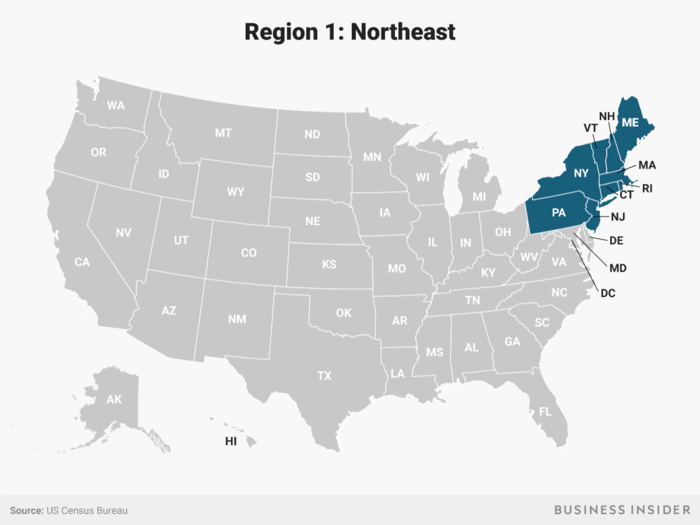
The Northeast includes Maine, New Hampshire, Vermont, Massachusetts, Rhode Island, Connecticut, New York, New Jersey, and Pennsylvania.

The Midwest consists of Ohio, Michigan, Indiana, Wisconsin, Illinois, Minnesota, Iowa, Missouri, North Dakota, South Dakota, Nebraska, and Kansas.

The South claims more states than any other region: Delaware, Maryland, Virginia, West Virginia, Kentucky, North Carolina, South Carolina, Tennessee, Georgia, Florida, Alabama, Mississippi, Arkansas, Louisiana, Texas, and Oklahoma.
Washington, DC, is also included in the South, according to the Census Bureau.

The West comprises Montana, Idaho, Wyoming, Colorado, New Mexico, Arizona, Utah, Nevada, California, Oregon, Washington, Alaska, and Hawaii.

Some of the agencies that use the OMB's map are the Environmental Protection Agency and the Department of Health, Education, and Welfare.

The four time zones in the contiguous US are Eastern, Central, Mountain, and Pacific. Alaska and Hawaii each have their own time zones, too.

There are 13 courts of appeals in total — the federal court and the DC court, representing the nation's capital, are the other two.

The Federal Reserve Banks are located in Boston, New York City, Philadelphia, Richmond, Atlanta, Chicago, Cleveland, Minneapolis, Kansas City, St. Louis, Dallas, and San Francisco.

The BEA uses this map to compare economic data between regions.

Today, the PAD uses the regional divisions to analyze the movement of crude oil and petroleum products throughout the country.

The South in particular tends to be up for debate.
 Should you be worried about the potential side-effects of the Covishield vaccine?
Should you be worried about the potential side-effects of the Covishield vaccine?
 India T20 World Cup squad: KulCha back on menu, KL Rahul dropped
India T20 World Cup squad: KulCha back on menu, KL Rahul dropped
 Sales of homes priced over ₹4 crore rise 10% in Jan-Mar in top 7 cities: CBRE
Sales of homes priced over ₹4 crore rise 10% in Jan-Mar in top 7 cities: CBRE

Copyright © 2024. Times Internet Limited. All rights reserved.For reprint rights. Times Syndication Service.